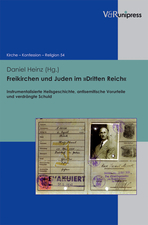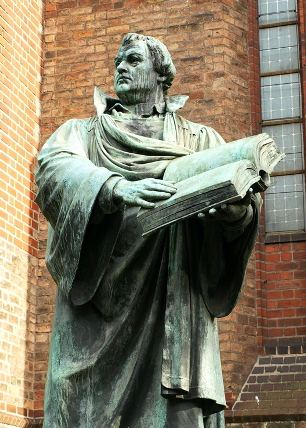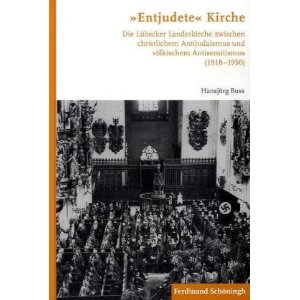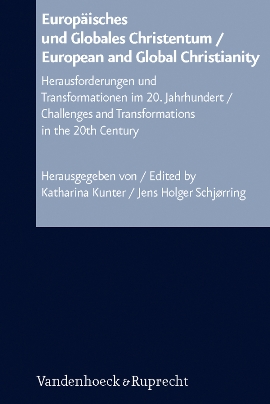Contemporary Church History Quarterly
Volume 18, Number 4 (December 2012)
Conference Report: Lessons and Legacies Conference on the Holocaust: “The Holocaust Today: New Directions in Research and Teaching,” November 1-4, 2012, Northwestern University.
By Lauren Faulkner, University of Notre Dame
Professor Emeritus Jacques Kornberg, from the University of Toronto, began his introduction to the panel on the German Protestant churches with the following observation: “I have been studying the Catholic Church in Germany for a long time. I’m happy to say, the Protestant churches were worse.” Kornberg drew a laugh from the sizeable audience, but it would be one of the very few moments of levity for the two panels of the conference devoted to investigating the German churches during the Third Reich.
Sponsored by the Holocaust Educational Foundation and Northwestern University, Lessons and Legacies continues to be a major conference for Holocaust scholars in North America and Europe. This year’s theme emphasized new research and teaching methods, and the scholars giving papers on the German churches set out to emphasize this in their investigations.
The panel chaired by Kornberg consisted of Robert Ericksen from Pacific Lutheran University, Christopher Probst from Saint Louis University, and Gilya Gerda Schmidt from the University of Tennessee, Knoxville. Ericksen’s paper, entitled “Antisemitism Under the Faulty Gaze of Early Postwar Germans,” took the case study of Klaus-Wilhelm Rath, professor of economics at the University of Göttingen, to complicate the current understanding of the denazification process. Using the example of Rath, who was part of the “terror group” of pro-Nazi academics at Göttingen, Ericksen outlines the process: an initial charge by the Allies led to relatively severe penalties, followed by years of appeals and a gradual softening of the penalties. Rath was dismissed summarily from his position in 1945. He lost his first appeal; second and third appeals led to his classification as a category III offender (assigned to those who had enthusiastically supported the regime). He appealed one final time, in 1950, sensing the change in mood towards denazification in West Germany, and taking advantage of the fact that denazification proceedings were now controlled by Germans. The final appeal resulted in a category IV classification, as a so-called Mitläufer, or “fellow traveler” of the regime. Rath was not satisfied – he wanted a full exoneration – but the change in status meant that he was no longer deemed an antisemitic agitator. This for a professor whose 1944 publications included a book depicting the Jews as responsible for the manipulation of the economy aimed at world domination, and who was designated in 1944 by the Nazi regime as one of the most important Nazi professors at Göttingen!
Like Ericksen, Probst presented material that comes in part from his recently published book on the demonization of Jews in Nazi Germany. Unlike Ericksen, whose focus is on members of the higher levels of the academy, Probst is interested in lower-level clergy in rural areas. In “German Protestant Attitudes Towards Jews and Judaism in Württemberg,” he explores the changes in antisemitism exhibited by Protestant pastors from the end of the Weimar Republic to the founding of the Federal Republic of Germany. This snapshot across the conventional time periods is useful in presenting threads of continuity that otherwise are more difficult to follow. Probst shows that distinctions between religious and racial antisemitism are important insofar as the former identified Jews as a religious “other” capable of redemption through conversion, while the latter employed racial or biological language to describe an irredeemable, immutable “other.” The problem he underscores in his paper is that the Lutheran pastors he examines in and around Stuttgart used both modes of expression in their discussions of Jews before, during, and after the Third Reich. These same men, who used antisemitic tropes in their lectures and sermons, ultimately became part of a “rectory chain” that hid some seventeen Jews in their parsonages between 1943 and 1945. One of his subjects, the Heimsheim pastor Heinrich Fausel, delivered a lecture on “the Jewish question” in 1934. Seeking to distance himself from biological and racial notions of Jewishness, he borrowed liberally from the Bible and the writings of Martin Luther to emphasize the failings of Jews across centuries. At the same time, he insisted that the rejection of Christ was the pivotal moment for the Jews as a Volk, and that the German Volk must defend itself against the “terrifying foreign invasion” that began in the nineteenth century, with the emancipation of the Jews. By 1943, Fausel was hiding Jews in his home. There is no evidence to indicate that he changed his mind about them, leading Probst to argue that people often behave in ways that contradict their own beliefs, and that German pastors during the Nazi period are no exception.
Schmidt’s essay, “The Dilemma of being a Good Neighbor and a Good Citizen in the Protestant Village of Süssen,” based on research for her book about rural Judaism during the Holocaust, asks the same probing questions that anchor Probst’s study. Süssen was (and continues to be) a small town not far from Stuttgart. Her subjects are civil servants, in this case the mayor, Fritz Saalmüller, and the town’s pastor, Martin Pfleiderer. Both had deep associations with Lutheranism in the area, and both were early Nazi enthusiasts. Pfleiderer later changed his mind and left both the Nazi Party in 1936, claiming he had been ignorant of the “true” ideology at play. He did not, however, mention the Jews of Süssen, who were deported and killed. Saalmüller, who became mayor in 1933, did not share Pfleiderer’s change of heart, and as mayor he was definitively antisemitic, enforcing the regime’s policies that forced Süssen’s Jews to sell their property before they were deported. Like the pastor, he was conscripted into the Wehrmacht upon the outbreak of war in 1939, but served for its duration. In 1944, he was ordered by a superior to shoot an American POW, which he did; in 1946, it was for this crime that he was arrested and sentenced to life in prison. Petitions for clemency came from all corners on his behalf, including from the bishop of Württemberg, who described Saalmüller as a “good, upstanding Christian” and loyal to his community. No mention was made of his dealings with the Langs and Ottenheimers, the Jewish families in Süssen who had been killed in the East. The postwar mayor of Süssen, August Eisele, was also not interested in pursuing these matters, and in fact for thirty years (!) suppressed Jewish reparations files submitted to him by three children of the deported Jewish families who had survived the Holocaust.
The panel analyzing the Catholic Church in Germany also treated antisemitism as its main focus. Panel members included Beth Griech-Polelle of Bowling Green State University, as chair; Martin Menke of Rivier College; Martina Cucchiara from Bluffton University; Kevin Spicer from Stonehill College; and commentator Suzanne Brown-Fleming, from the U.S. Holocaust Memorial Museum. Like those who presented on Protestantism, these scholars aimed to complicate traditional notions of Catholic antisemitism and the ways it manifested itself during the Third Reich. The panelists limited their explorations to the pre-1939 period.
Menke’s paper, “German Catholicism and Nazi Racism, 1933,” highlighted a pressing question iterated recently by Thomas Brechenmacher: where is the agency in the Catholic Church in twentieth century Germany, particularly where antisemitism is concerned? Menke considered multiple answers: the individual bishops, the bishops as a whole, the Center Party leaders, and German Catholic laity. Although he did not tender an explicit answer to this thorny question, his paper made clear that he judged all parties at least partly responsible. He related what historians now commonly accept: following the examples of their Catholic bishops, Catholics in Germany rejected Nazi racism – understood distinctly here from antisemitism – as an intrinsically un-Christian ideology. On this ground, the episcopate condemned the Nazi movement as a whole. Antisemitism, however, was a different matter: In fact, the only public figure to denounce racism and antisemitism officially was Cardinal Theodor Innitzer of Austria, who stressed Nächstenliebe vis-à-vis the Jews. (Innitzer was an active proponent of the Austrian fascist government of Dollfuß and Schuschnigg; he also endorsed the 1938 Anschluß, signing a declaration with an approving “Heil Hitler!”.) Menke is particularly hard, and justifiably so, on the bishops. They stated frequently, both during and after the Third Reich, that their priority was to defend the Church. Properly understood, this should have extended to a condemnation of any immoral action undertaken by the state. The bishops did not do this for several reasons: the Nazis did not take over the state until 1933; by that time, communism was accepted as the greater evil to be combatted; and finally, the Church treated Nazism as it did any other heresy, calling for a slow, unhurried examination. However, by the end of March 1933, when Hitler consolidated his hold on power, the bishops were ready to cooperate with his government, and set an example that permitted the acceleration of latent antisemitism among the Catholic populace.
Cucchiara’s work on Catholic nuns in Nazi Germany introduces women agents to a scene that frequently focuses on men as the exclusive subjects. In “Jewish Girls in Catholic Schools in Nazi Germany,” she studies the German-based School Sisters of Notre Dame, whose motherhouse was located in Munich until the 1950s. Their behavior between 1933 and 1938 complicates the conventional understanding of Catholic nuns as rescuers and convents as good hiding places for Jews. Cucchiara finds that convent-run schools were spaces of fusion, in which Catholicism and Nazism co-existed with the full knowledge, even open support, of the nuns. Jewish girls did experience more safety hidden in convents in comparison to other hiding places they may have discovered, but this does not follow, she argues, that Nazism failed to penetrate. The nuns in question worked to preserve their classrooms as distinctly Catholic spaces in the Third Reich. However, preservation often occurred with the least difficulty through integration with the state. As a result, they worked hard to highlight the positive, good works of Hitler and his regime, and emphasized continuity and sacrifice, bringing the regime more closely in line with their own religion. Cucchiara reports that Jewish girls remembered later that there was a remarkable absence of antisemitism exhibited by their religious caretakers, but this does not mean that the convents were hotbeds of anti-Nazi activity. Cucchiara concludes by urging historians to avoid imposing a false separation of religion, as represented by Church members and leaders, and Nazi Germany, and to treat witnesses who testify to this separation with care.
Kevin Spicer’s paper, “The German Catholic Church and the ‘Judenfrage’ in Weimar Germany” rounded out the panel, concerned explicitly with the connection between religious and racial antisemitism during the Weimar era. He identifies the dual pillars of the “Jewish question” for Catholics at that time: the theological pillar, identifying conversion as a possible remedy, and the societal pillar, lamenting and fearing the influence of Jews on German-Christian culture and society. During the years of the republic, a third pillar evolved, identifying Jews as a racial and biological enemy, though many Catholics continued to adhere to the more traditional, culture- and social-based aversion to Jews. Spicer’s most intriguing revelations involve Augustin Bea, the provincial superior of the Jesuits in Germany from 1921 to 1924. Bea was convinced that antisemitism was inextricably linked to anti-Catholicism; occasionally using anti-Jewish and antisemitic language, he and others defended Jews insofar as they, like Catholics, were a persecuted religious minority in Germany, and that the problem could be better solved by working with, not against, them. Otherwise, they would continue to pose a distinct potential danger to future German prosperity. His role in the production of Nostra Aetate at Vatican II, and his work to bring Jews and Christians into greater and more open dialogue in the post-Holocaust world, present Bea as a staunch opponent of discrimination and prejudice and a champion of ecumenism (unusual for a Catholic). However, in the early 1920s in Germany, Bea had not yet found this orientation.
It was fitting that Suzanne Brown-Fleming began her comments with Nostra Aetate, that great and necessary Church document promulgated by Pope Paul VI in 1965 as part of Vatican II. Its importance to the post-Holocaust Church is undeniable, but Brown-Fleming adeptly highlighted the individuals presented by the panel, who in the 1920s and 1930s were still mired in anti-Jewish, antisemitic ways of thinking, but who nonetheless began to grope toward reforming their interactions with their Jewish neighbours. Although Menke, Cucchiara and Spicer present historical figures who found ways to accommodate a regime that ultimately tried to solve the “Jewish problem” by physically exterminating them, the Catholic bishops, the School Sisters, and Bea never condoned the extreme racial rhetoric of Nazism. She concluded by citing one of the most significant questions that calls for further investigation, that could easily be applied to the Protestant context as well: why did some Catholics resist and other did not, and of those who resisted, what prompted them to do so?
By way of concluding this report, I want to relate an unexpected occurrence that unfolded outside of the two panels devoted to the study of the German churches, that nevertheless has a direct bearing on scholars of the German churches. Immediately preceding the panel on German Catholicism was a workshop on new cultural approaches to the Holocaust. The afternoon workshop, featuring Doris Bergen, Alon Confino, Mark Roseman, and Amos Goldberg, attracted a large audience and engendered a lively discussion, following remarks that concentrated on the role of agency and that called for the decentering of “race” from the story of the Holocaust. Religion, Christianity specifically, was identified as an element that needed to be reinserted vigorously into the narrative to make the Holocaust imaginable and representable. In the Q&A, Alan Steinweis questioned the presentation of this as innovative and “new”, pointing to Bergen and several others in the audience, including Kevin Spicer, Robert Ericksen, and Dagmar Herzog, who have contributed substantial and acclaimed works on the role of religion and the Christian churches in the Holocaust. As a spectator who had listened closely to the remarks, I found myself in agreement with Steinweis: surely those of us who work on the German churches did not produce our work in a vacuum? Hasn’t the field of modern German history been moving for a while now towards the full integration of religious history into its narratives? The workshop is perhaps a good reminder that this integration has not yet been achieved, and that studies of the German churches, both Protestant and Catholic, must continue to present themselves as vital to the study of German society and culture as a whole, and not simply as “church history” or “religious history,” in order to explain as accurately as possible how attitudes about “otherness” can lead to persecution and genocide. In Nazi Germany, racism and Social Darwinism is part of this, but Christian belief that for centuries had depicted the Jews as “other” is just as culpable. In the wake of the turbulent exchange, as the scholars for the panel on German Catholicism settled into their seats and awaited their audience, Kevin Spicer summarized it best: “Our colleagues who don’t normally deal with the churches are discovering religion, and we’re all very excited about that.”
 Andrew White is an Anglican priest who was posted in 2005 to St George’s Parish in Baghdad, which must be physically the most dangerous, and possibly spiritually the most challenging of all Anglican parishes anywhere. This short and vivid autobiographical account of his ministry there is a witness to a costly Christian discipleship of notable significance, and throws light on a unique segment of contemporary church history.
Andrew White is an Anglican priest who was posted in 2005 to St George’s Parish in Baghdad, which must be physically the most dangerous, and possibly spiritually the most challenging of all Anglican parishes anywhere. This short and vivid autobiographical account of his ministry there is a witness to a costly Christian discipleship of notable significance, and throws light on a unique segment of contemporary church history.






